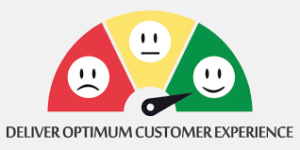Predictive analytics play a critical role in helping companies strategically identify and target customers. But how do you continue to reach customers once you’ve already attracted them to your company? How do you keep them coming back? Customers want personalized, responsive service, and leveraging big data can play an important role in improving their experiences with your company.
Analytics for Addressing Customer Issues
Just like predictive analytics is crucial for identifying your ideal customer, it plays an equally important role in making that customer’s experience with your company the most positive it can be. Rather than guessing what your customers want or need, you can collect data on your customer’s interactions on your website, track their buying behavior, and chart their journey with your company from start to finish. With this information, you can determine future products your customers will buy, offer product recommendations, and provide personalized customer support. Data have the potential to make every interaction customers have with your company impactful by predicting their needs and reducing opportunities for them to have a negative experience with your brand.
Providing a Smooth Experience
A significant part of improving your customers’ experience is making sure that their interaction with your company is as seamless as possible. From their first interaction to their last, you want to chart your customers’ individual purchasing journeys with your company by collecting and analyzing data on customer touchpoints. These touchpoints include pre-purchase experiences with your brand like ads, social media, and emails to purchase interactions such as your website, salespeople, and events. Post-purchase touchpoints, including surveys, loyalty programs, personalized thank you notes, and customer service interactions, can also provide important insight into customers’ experience with your company.
To make your customers’ experience as smooth as possible, collect detailed information about their use of your website. How much attention do they give to areas of your site? Are there any problem pages? Is the process for purchasing a product simple and intuitive? Where do customers need support with the process? Considering such questions and collecting the relevant data can help you determine usability issues and improve customers’ interactions with your company. Furthermore, knowing that customers may use multiple devices to access your company (e.g., laptop, tablet, and smartphone), their ability to transition from one device to another while maintaining a high-quality experience with your company’s site should be seamless.
Connecting the Dots
Between mapping your customers’ journeys and providing a unified experience across a variety of devices and interactions, your company has the huge task of connecting the dots across platforms and customers. You need to effectively integrate all the different channels through which customers interact with your company into a cohesive understanding of what the data are telling you. Having a big picture understanding of how different channels interact and affect the customer journey allows you to make more strategic decisions on how to improve customer experience.
A visual dashboard can help you develop this more holistic understanding of your customers. While a macro-view of your customer data is important for identifying trends and journey mapping, the ability to zoom in on specific customer interactions is also useful. A micro-view will provide you with specific information that allows you to improve your customer relationships. A well-designed dashboard can provide you with this ability to zoom in and out on customer behavior to better meet their needs and adjust your company’s strategy in real-time.
Just like collaboration is important in targeting customers through account-based marketing, it’s also important for improving the customer experience. Your company will need to work together across departments to share data and strategize. Tools and processes that facilitate collaboration and sharing across teams will help increase efficiency and allow your company to quickly respond to customer needs, ultimately resulting in a better end-user experience that will keep them coming back.

